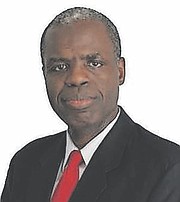By NEIL HARTNELL
Tribune Business Editor
nhartnell@tribunemedia.net
The Central Bank’s governor yesterday revealed that restrictions imposed last year in the immediate aftermath of the COVID-19 pandemic’s outbreak had “provided at least a $200m cushion for the external reserves”.
John Rolle, speaking at a 2021 second quarter and half-year economic briefing, disclosed that the final remaining measures - the prohibitions on broker/dealers, individual Bahamians and residents investing in overseas securities and real estate via the Investment Currency Market (ICM) - will almost certainly be removed before 2021 year-end.
“Taking account of the improved foreign exchange market conditions, the Central Bank has already removed the majority of the conservation measures that were introduced in 2020,” he said. “The remaining measures relate to capital market investments, principally through the local broker/dealers or securities market firms, and the investment currency market. These restrictions are under review for timing that would see them removed before the end of 2021.”
The Central Bank chief, responding to a later Tribune Business question, said that and other measures which included restrictions on dividend payments by the Canadian-owned banks and the National Insurance Board’s (NIB) repatriation of its foreign currency investments, had “conservatively” produced a $200m buffer to maintain the external reserves at acceptable levels until the government’s overseas financing activities kicked-in.
Holding sufficient foreign reserves is vital to maintaining the Bahamian dollar’s one:one peg to its US counterpart, and Mr Rolle said: “I believe, looking from the start of the pandemic to the point at which we saw the government’s financing activity start, we estimate there’s at least $200m-plus of cushion that we provided to the foreign reserves over that period.
“The banking sector measures added close to $100m in cushion. In ordinary year, and given the trends, you’re looking at close to $100m in transactions that happen by way of investment by residents abroad. We’d have received some conversion from NIB that was substantial. That added to the reserves.
“When you look at these and some of the other measures, the $200m-plus is a conservative projection in terms of the cushion provided. But understand that these were sort of one-offs that might have created a little bit of space time wise.
“Once you exhaust that protection, what is more important is that the start of spending on the Government side has to appropriately matched by foreign currency financing as you were stimulating continued calls for spending that had to be taken into account.”
Elsewhere, Mr Rolle said just 2.3 percent of all outstanding loans to businesses and households remain in COVID-19 related deferral programmes compared to around one-third of all credit facilities at this time last year when pandemic-related uncertainty was at its peak.
However, non-performing loans have increased to 9.5 percent of all outstanding private sector credit compared to just below 8 percent prior to the pandemic. “Turning to the financial sector, the pandemic has resulted in increased lending risks and credit losses to domestic institutions,” Mr Rolle said.
“However, banks continue to maintain high levels of excess capital and retained earnings to absorb these losses and have, in most respects, already made sizeable allowances for losses. The associated non-performing loans are expected to continue to rise in the near-term, as more clarity emerges about the employment status of borrowers who experienced difficulties as a result of the pandemic.
“At present, the non-performing loans rate has risen to 9.5 percent of private sector loans compared to an estimate just below 8 percent before the pandemic struck. In June, banks were still extending repayment deferral arrangements on just 2.3 percent of loans to businesses and households,” the Central Bank governor added.
“This was a considerable reduction from slightly more than one-third of such facilities one year ago. This, however, understates the remaining difficulties for borrowers because some forbearance also continues for many who are still only able to partially resume loan payments. Underemployment continues to be a factor for some borrowers who have returned to work.
“Bank lending has continued to be constrained because of heightened risks and subdued demand for credit. As such, there has been further overall reduction in credit to the private sector in the first half of 2021. On the flip side, liquidity has accumulated further.”





Comments
Use the comment form below to begin a discussion about this content.
Sign in to comment
Or login with:
OpenID